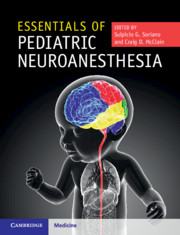15 results
Chapter 8 - Congenital Neurosurgical Lesions
-
-
- Book:
- Essentials of Pediatric Neuroanesthesia
- Published online:
- 02 November 2018
- Print publication:
- 22 November 2018, pp 58-64
-
- Chapter
- Export citation
Chapter 14 - Traumatic Brain Injury
-
-
- Book:
- Essentials of Pediatric Neuroanesthesia
- Published online:
- 02 November 2018
- Print publication:
- 22 November 2018, pp 112-119
-
- Chapter
- Export citation
Dedication
-
- Book:
- Essentials of Pediatric Neuroanesthesia
- Published online:
- 02 November 2018
- Print publication:
- 22 November 2018, pp v-vi
-
- Chapter
- Export citation
Chapter 1 - Developmental Approach to the Pediatric Neurosurgical Patient
-
-
- Book:
- Essentials of Pediatric Neuroanesthesia
- Published online:
- 02 November 2018
- Print publication:
- 22 November 2018, pp 1-8
-
- Chapter
- Export citation
Index
-
- Book:
- Essentials of Pediatric Neuroanesthesia
- Published online:
- 02 November 2018
- Print publication:
- 22 November 2018, pp 190-196
-
- Chapter
- Export citation
Copyright page
-
- Book:
- Essentials of Pediatric Neuroanesthesia
- Published online:
- 02 November 2018
- Print publication:
- 22 November 2018, pp iv-iv
-
- Chapter
- Export citation
Chapter 7 - Anesthesia for Posterior Fossa Craniotomy
-
-
- Book:
- Essentials of Pediatric Neuroanesthesia
- Published online:
- 02 November 2018
- Print publication:
- 22 November 2018, pp 52-57
-
- Chapter
- Export citation
Preface
-
- Book:
- Essentials of Pediatric Neuroanesthesia
- Published online:
- 02 November 2018
- Print publication:
- 22 November 2018, pp xi-xii
-
- Chapter
- Export citation
Contents
-
- Book:
- Essentials of Pediatric Neuroanesthesia
- Published online:
- 02 November 2018
- Print publication:
- 22 November 2018, pp vii-vii
-
- Chapter
- Export citation
Contributors
-
- Book:
- Essentials of Pediatric Neuroanesthesia
- Published online:
- 02 November 2018
- Print publication:
- 22 November 2018, pp viii-x
-
- Chapter
- Export citation

Essentials of Pediatric Neuroanesthesia
-
- Published online:
- 02 November 2018
- Print publication:
- 22 November 2018
Chapter 29 - Anesthesia for Neurosurgery in Infants and Children
- from Section 4 - Neuroanesthesia
-
-
- Book:
- Gupta and Gelb's Essentials of Neuroanesthesia and Neurointensive Care
- Published online:
- 19 June 2018
- Print publication:
- 21 June 2018, pp 205-213
-
- Chapter
- Export citation
17 - Anesthetic-Induced Neurotoxicity
- from Section 2 - Newborn and Infant Anesthesia
-
-
- Book:
- Essentials of Anesthesia for Infants and Neonates
- Published online:
- 09 February 2018
- Print publication:
- 22 February 2018, pp 163-170
-
- Chapter
- Export citation
14 - Principles of paediatric neurosurgery
- from Section 3 - Neuroanaesthesia
-
-
- Book:
- Core Topics in Neuroanaesthesia and Neurointensive Care
- Published online:
- 05 December 2011
- Print publication:
- 13 October 2011, pp 205-221
-
- Chapter
- Export citation
Contributors
-
-
- Book:
- Core Topics in Neuroanaesthesia and Neurointensive Care
- Published online:
- 05 December 2011
- Print publication:
- 13 October 2011, pp vii-x
-
- Chapter
- Export citation



